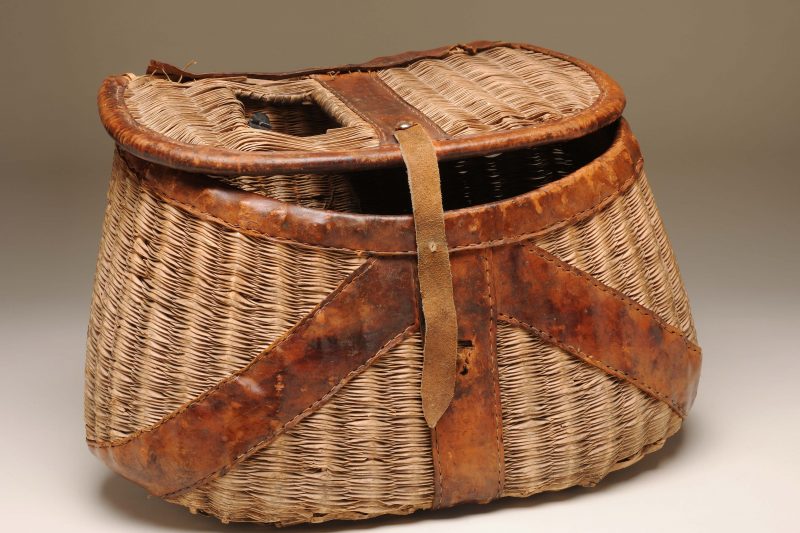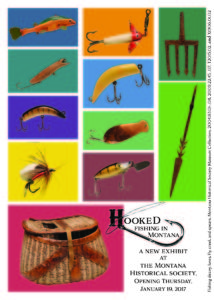
Wicker creel, a gift from the Penhale families of Butte, is part of "Hooked: Fishing in Montana"
“Hooked: Fishing in Montana,” a new exhibit at the Montana Historical Society in Helena celebrates Montana’s fabled waters and abundant variety of fish.

Fishing has brought and continues to bring families, friends, and communities together on and off the water. “Hooked” highlights how Montanans, including the state’s Fish Wildlife and Parks agency, preserve the state waters to ensure that these fishing adventures can continue. Through art and artifacts from the Montana Historical Society and loans from the family of famed novelist Norman Maclean and others, the exhibit explores family ties and communities bound together by fishing; tribal lifeways and knowledge; and the art and craft of creating fishing rods, tying flies, and building canoes.
Highlights of “Hooked: Fishing in Montana” include the following:
- Nez Perce-style dugout canoe built by Ed Lamorais and Alikot (Okilut), ca. 1860, and used on the Flathead River. Canoes were a part of everyday life for Nez Perce peoples. They allowed families to follow migrating fish and to travel between settlements along rivers. This canoe is one of several styles of Nez Perce dugout canoes. Although it is typical of what Nez Perce peoples used while fishing, this particular canoe was used primarily as a ferry on the Flathead River west of Ronan. Olikut, Chief Joseph’s younger brother, helped craft this canoe when visiting the Nez Perce wife of a ferry operator on the Flathead River.
- Reproductions of tools used by indigenous peoples made by Tim Ryan of EthnoTech, LLC. Salish peoples depended on spear fishing to harvest spawning cutthroat in the spring and bull trout in the fall. Kootenai, Salish, and Pend d’Oreille peoples have long depended on a variety of fish, such as trout, suckers, and whitefish. Fishing was especially important before the acquisition of horses increased their ability to hunt bison east of the Rocky Mountains.
- Fishing rods and items from John Maclean, including three bamboo rods belonging to three generations of Macleans, all used to fish Montana waters. Also on display: Norman Maclean’s flies, mentioned in A River Runs through It; the author’s fishing shirts; and hand-tied flies sent to John Maclean by George Croonenberghs.
- Antique split-cane bamboo rods used by Montanans, including Helena banker Shirley Carter Ashby. Split-cane bamboo rods became popular in America in the mid to late 1800s, at the same time as growing numbers of anglers were getting a taste of western waters. After World War II, fiberglass and graphite rods became popular alternatives.
- Hand-carved lures and ice-fishing decoys. Spearfishers sometimes use decoys to attract fish, such as northern pike. For some, the decoy is discarded at the end of the season; for others, decoys are art, with fine carvings and colorful designs.
- Historic artifacts and photographs from Montana’s Fish, Wildlife & Parks, including a milkcan, aerator, and pack saddle used to transplant fish. Brown, rainbow, and brook trout were planted by sportsmen and government agencies starting in the 1800s. In the 1970s, Montana Fish, Wildlife & Parks stopped stocking trout in rivers and streams after studies revealed that wild fish thrive when not competing with hatchery fish. Montana’s stream protection bill, the first of its kind in the nation, protects streams’ meandering courses. Montana Fish, Wildlife & Parks helped develop the Blue Ribbon stream classification system in 1959, leading the nation in stream conservation and access.
- Historic photographs from the Montana Historical Society Photograph Archives and on loan from other collections; and paintings by Ralph DeCamp, among others.
Learn more at montanahistoricalsociety.org.